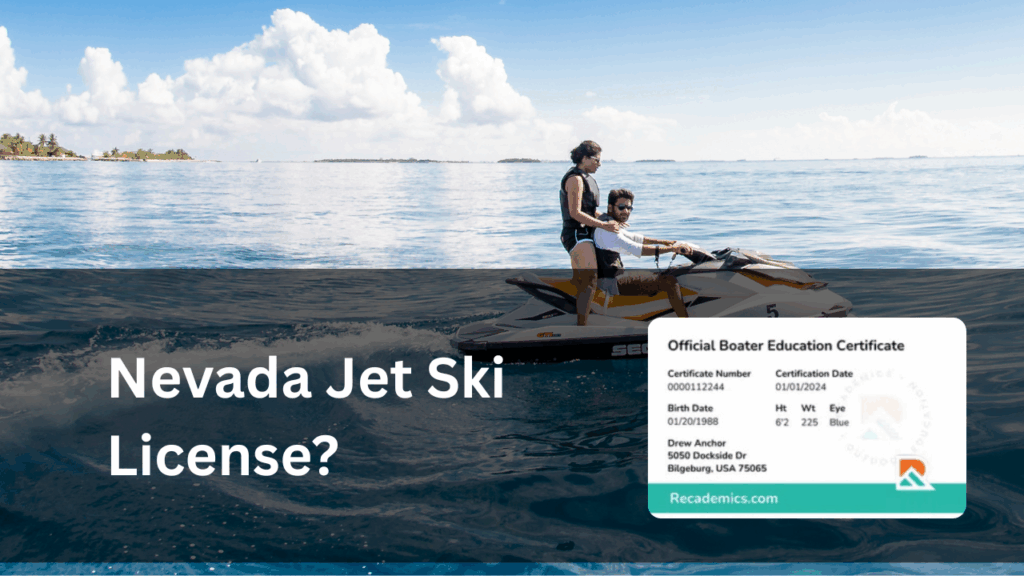Take an Official State-Approved Boater Safety Course
Nevada Jet Ski License
Do You Need a License to Drive a Jet Ski in Nevada?
Quick Answer: Yes. In Nevada, anyone born on or after January 1, 1983 must complete a state-approved boater education course (jet ski license) before operating any motorized vessel over 15 horsepower. This includes jet skis and other personal watercraft.

If you plan to ride a jet ski in Nevada, you might be wondering whether you need a license. While Nevada doesn’t issue a traditional “jet ski license,” most riders are required to complete an approved boater education course before operating a personal watercraft (PWC). This certification proves you understand the state’s boating laws and safety rules and it’s mandatory for many operators.
Once you pass the course, you’ll receive a Boater Education Card, often called a “boating license” or “Jet Ski License”. This card must be carried with you whenever you’re operating your jet ski and remains valid for life.
Age Requirements for Operating a Jet Ski in Nevada
To legally operate a jet ski in Nevada, you must be at least 14 years old. Younger riders are not permitted to operate a PWC under any circumstances.
If you’re towing a skier, tuber, or wakeboarder, you must be at least 16 years old, or 14 with a supervising adult aged 18 or older on board. Everyone on the jet ski, including passengers and anyone being towed, must wear a U.S. Coast Guard–approved life jacket at all times.
Jet Ski Rentals and Visitors in Nevada
Visitors can legally rent and operate a jet ski in Nevada as long as they meet the same education and age requirements. Rental companies typically verify your boater education card before allowing you to ride.
If you were born before January 1, 1983, no course is required — but safety training is still highly recommended.
Penalties for Operating Without a Boater Education Card
Operating a jet ski without the required boater education card can result in fines and citations. In some cases, law enforcement may require offenders to complete the course as part of the penalty. Failing to carry your card while riding can also lead to warnings or fines.
What Counts as a Personal Watercraft (PWC) in Nevada
In Nevada, jet skis, Sea-Doos, and WaveRunners all fall under the category of personal watercraft (PWC). A PWC is any motorized vessel under 16 feet in length that uses a jet pump instead of a propeller. Because they’re considered boats under state law, all the same boating safety and registration rules apply.

Nevada Jet Ski Rules and Operating Restrictions
Jet skis are treated like any other motorboat under Nevada law, which means you must follow standard boating rules, including speed zones and right-of-way laws. Here are some key points to remember:
You must wear your engine cut-off lanyard (kill switch) when operating.
Jet skis cannot be operated between sunset and sunrise or in poor visibility.
Operating a jet ski while under the influence of alcohol or drugs is strictly prohibited.
You must yield to non-motorized vessels like sailboats, kayaks, and paddleboards.
Following these rules helps ensure your safety and the safety of others on the water.
How to Get Your Nevada Jet Ski License
Getting certified to drive a jet ski in Nevada is quick and straightforward. Here’s how:
Take an Approved Boater Education Course
You can complete the course online through an approved provider recognized by the Nevada Department of Wildlife (NDOW). Recademics is an approved provider of the Nevada Boater Safety Course.Pass the Final Exam
The exam covers navigation rules, safety equipment, PWC operation, and environmental laws. Most providers require a passing score of at least 80%.Receive Your Boater Education Card
After passing, you’ll get a lifetime card or certificate that proves you’re legally authorized to operate a jet ski in Nevada.Carry Your Card While Operating
You must have the card with you whenever you’re operating a jet ski or other motorized vessel.
Additional Nevada Jet Ski Safety Tips
Always check local waterway regulations before launching.
Keep a safe distance from swimmers, docks, and other boats.
Make sure your jet ski is properly registered and displays valid decals.
Never allow inexperienced riders to operate without supervision and certification.
Boating
- Alabama
- Alaska
- Arizona
- Arkansas
- California
- Colorado
- Connecticut
- Delaware
- Florida
- Georgia
- Hawaii
- Idaho
- Illinois
- Indiana
- Iowa
- Kansas
- Kentucky
- Louisiana
- Maine
- Maryland
- Massachusetts
- Michigan
- Minnesota
- Mississippi
- Missouri
- Montana
- Nebraska
- Nevada
- New Hampshire
- New Jersey
- New Mexico
- New York
- North Carolina
- North Dakota
- Ohio
- Oklahoma
- Oregon
- Pennsylvania
- Rhode Island
- South Carolina
- South Dakota
- Tennessee
- Texas
- Utah
- Vermont
- Virginia
- Washington
- West Virginia
- Wisconsin
- Wyoming
